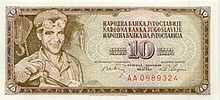Alija Sirotanović
| Alija Sirotanović | |
|---|---|
 Sirotanović on the 20,000 Yugoslav dinar banknote issued in 1987 | |
| Born |
14 August 1914 Orahovo, Condominium of Bosnia and Herzegovina, Austria-Hungary |
| Died |
16 May 1990 (aged 75) Breza, SR Bosnia and Herzegovina, SFR Yugoslavia |
Alija Sirotanović (14 August 1914 – 16 May 1990)[1] was a Yugoslav miner, Hero of Socialist Labour and perhaps the most famous of all Yugoslav udarniks. He was held up by the Communist Party of Yugoslavia to be a model of a hard-worker in the former Yugoslavia.[2]
Early life and family
Alija Sirotanović, a Muslim and an ethnic Bosniak, was born in Orahovo, a village in central Bosnia near the town of Breza, and grew up in Trtorići, another nearby village. He was born in 1914, while Bosnia was a part of the Austro-Hungarian Empire. He had six brothers and two sisters, all of whom were miners. One of his brothers, Ahmed, died in a mining disaster in 1970.
A coalmining contest
A worker in a coal mine in Breza, Bosnia and Herzegovina, Sirotanović became famous when he and his crew mined 152 tons of coal in one shift.[3] This feat set a world record in coal mining and thus defeated another "model worker", Soviet miner Aleksei Stakhanov.
Political implications
As Yugoslavia was in political confrontation (see: Tito-Stalin split) with the Soviet Union around the time of the contest, his accomplishment was widely praised and publicised by the Communist Party of Yugoslavia. Josip Broz Tito is said to have offered to fulfill any wish Sirotanović had, but all Sirotanović is reported to have requested was a bigger shovel.[3] Tito granted his wish, and the larger shovel that was designed for him was later named after him: Sirotanovićka. He was offered an appartement in Breza, but he refused and decided to stay in his house in Trtorići.[3] The state also started building him a new house in his village Trtorići, but it was never finished. In 1987, Zabranjeno Pušenje recorded a song titled "Srce, ruke i lopata" (Heart, Hands and Shovel), paying tribute to Comrade Alija, the model of a hard working, modest man.
Banknote
He was pictured on the 20,000-Yugoslav dinar banknote, but was often wrongly claimed to be pictured on the 10-dinar banknote. Despite the obvious similarities, the 10-dinar banknote and its 1000-old-dinar predecessor with the same design are older (1955) and showed Arif Heralić, a metal worker working on a blast furnace in Zenica. The newer 20,000-dinar banknote was brought out on May Day in 1987.
References
- ↑ "SDA tvrdila da je Alija Sirotanović izmišljen lik". Avaz. 14 May 2013. Retrieved 15 May 2013.
- ↑ "Legenda o Aliji Sirotanoviću još uvijek živi: Druže Tito, dajte mi veću lopatu". Krajina. 13 May 2013. Retrieved 15 May 2013.
- ↑ 3.0 3.1 3.2 BHT episode about Alija Sirotanović on YouTube
External links
- http://www.bhdani.com/arhiva/102/citanka02.htm
- http://www.bhdani.com/arhiva/186/t18611.shtml
- Alija on Leksikon YU mitologije
- Text of song Srce, ruke i lopata
